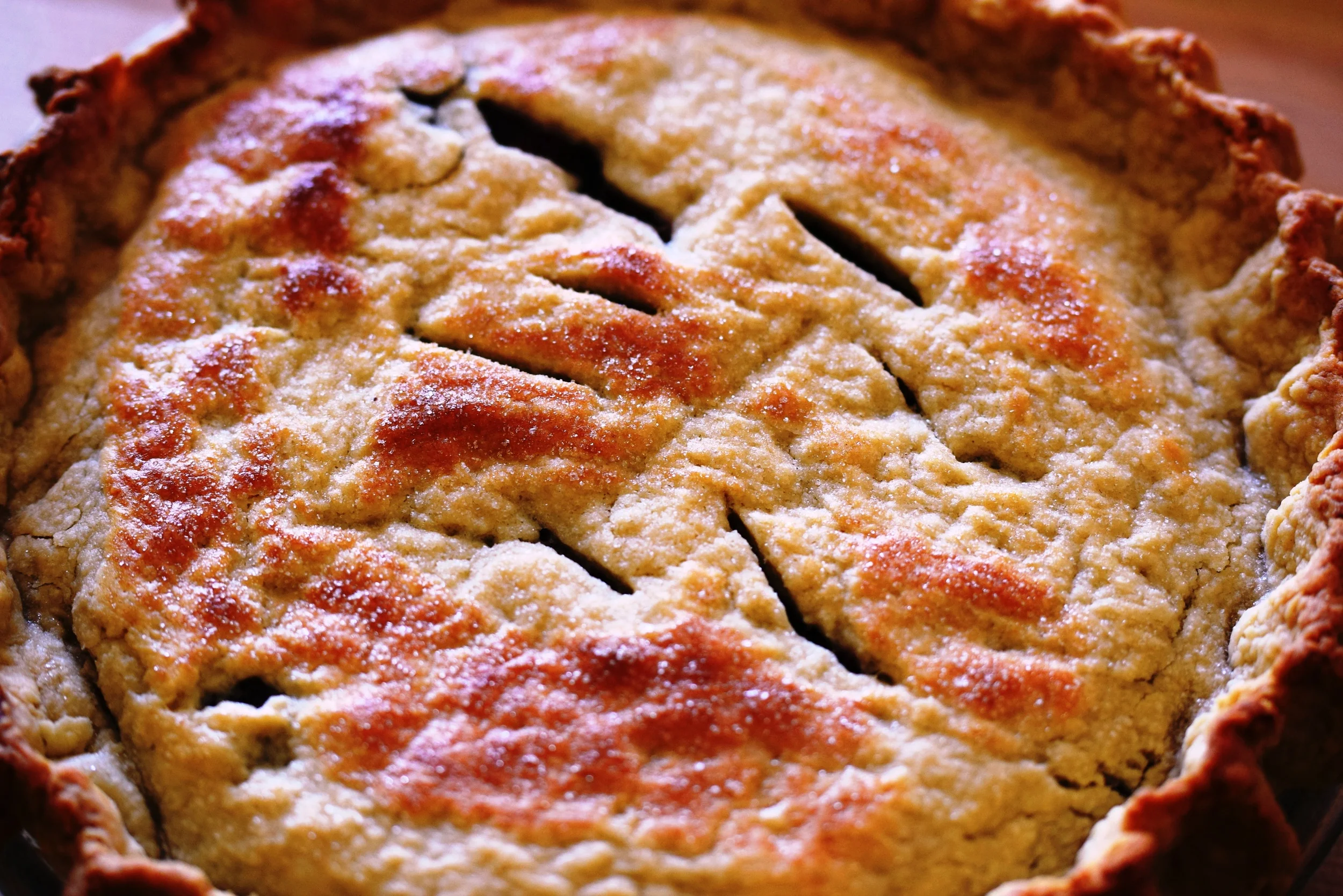(Click on the photo above for a demonstration of making and rolling out pie dough!)
There are many pie crust recipes, and just as many opinions about what makes the best crust! I grew up eating lard pie crust, and it is still my favorite. But, there are quite a few folks that are lard-averse I have learned. So I came up with this recipe using lard (if you care to) or shortening, as they both make a tender, flaky crust, and also butter, for rich flavor. This is a basic, and pretty much no-fail recipe. The dough is easy to work with, and yields a flavorful, flaky, golden brown crust. Surprise ingredients include vinegar and vodka! Because vodka is primarily alcohol, it immediately evaporates when it hits the heat of the oven creating air pockets in the crust. I first discovered this trick in an issue of Cooking Illustrated and it definitely improves the lightness of the crust.
There are many factors that effect the finished crust. WEIGH the fat, it is the the most accurate way to measure, and no messy measuring cups! The amount of liquid needed will vary with the humidity and moisture content of the flour. For this reason I recommend using a pastry blender to mix the dough by hand if you're a beginner, to get the "feel" of a properly mixed dough. It takes a little experience to become adept at making pie crust, so practice! Once you're familiar with how a good pie dough feels, by all means use a food processor, being cautious not to over-process, resulting in a less flaky crust. With a little practice you'll be an expert pie baker in no time!
2 1/2 cups all-purpose or unbleached flour
1 1/2 teaspoon salt
1 teaspoon sugar (omit for quiche or other savory dishes)
4 ounces cold shortening or lard, cut in pieces
4 ounces cold butter, diced
2 Tablespoons vodka, chilled (if you don't want to use Vodka, increase vinegar and water by 1 Tablespoon each)
1 Tablespoons cider vinegar, chilled
2-4 Tablespoons ice-cold water or milk
Make dough:
Combine flour, salt and sugar (if using) in a large bowl (or bowl of a food processor, if using). Add butter and lard or shortening and cut in with pastry blender until the fat is about the size of large peas. (If using a food processor, the fat should be in large pieces, about one inch.) Sprinkle the vodka, vinegar, and 2 Tablespoons of the water over the flour mixture. Cut in and gently toss (or process) just until dough begins to come together; if dough still has a lot of dry flour, add more water, a Tablespoon at a time until dough comes together. (Use care not to add too much liquid, or the crust will shrink and not be as flaky. The dough should not be wet or sticky.) Stop when the dough still looks a bit "shaggy".
Lay out a large piece of plastic wrap on the counter and dump the dough out onto it. Pull the corners of the plastic wrap up and use the wrap to form the dough into a ball. Divide into two equal pieces (weigh each half) and wrap in plastic, using the plastic to form each half into a disc, about an inch thick. Refrigerate for at least an hour before rolling out.
Roll out dough:
Flour a board or the counter top*. Place a disc of dough on the flour and dust the top of the dough with flour. Flour the rolling pin and roll the dough in one direction, turning a quarter turn after each roll, dusting the work surface with more flour as often as necessary to keep it from sticking. The secret to keeping the dough from sticking is to keep it moving, and keeping the surface well-floured. Roll to a 12-inch circle for a 9-inch pie plate. If it is not a perfect circle, don't worry! Trim it before placing in the pie plate and use the scraps to repair any holes, tears or voids because there will inevitably be some of those! Roll the dough around the rolling pin until all the dough is wrapped around it. Unroll onto the pie plate (glass or ceramic is best!) and gently ease the dough into the pan. Now is the time to use those scraps to repair anything that needs fixing! Tuck excess dough under and press together firmly if making a single crust pie and crimp edge all the way around. (See video for blind baking instructions.)
If making a double-crust pie roll out the second disk of dough, fill the pie, then repeat rolling the dough around the rolling pin. Brush the rim of the bottom crust with a bit of water or milk and unroll dough over the filling. Press the dough lightly to seal, the trim the dough (a 2-inch overhang is about right), if needed, and tuck under the top and bottom crust, and crimp. Cut vents in the top of the pie to allow steam to escape. Brush the top with light cream or whole milk and sprinkle generously with sugar. Bake according to recipe instructions.
*Alternately, dough can be rolled between large sheets of plastic wrap or parchment paper, eliminating the need for flour. When the proper size and thickness is achieved, remove top sheet of wrap or paper, sprinkle with a bit of flour, roll around pin, then unroll into the pie plate and continue as above.
























